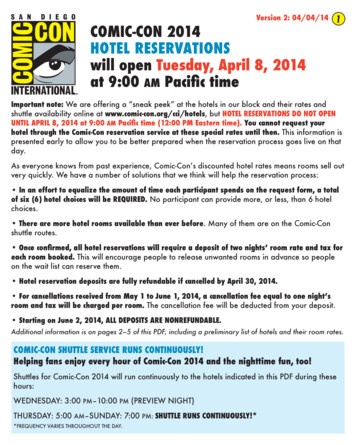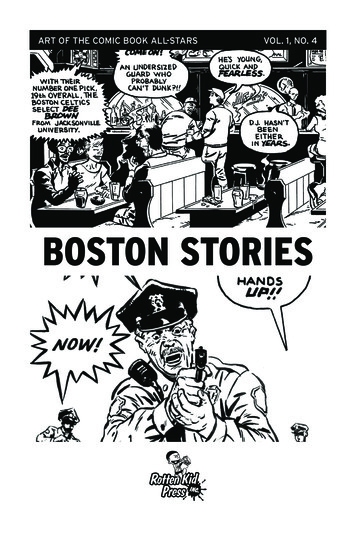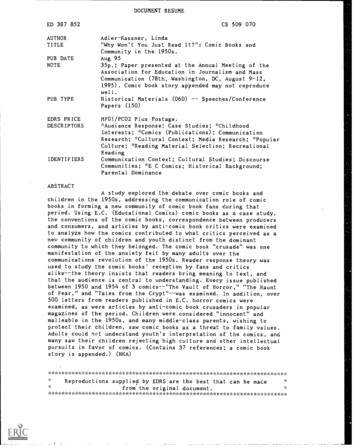
Transcription
Encyclopedia of Comic Booksand Graphic Novels
EDITORIAL BOARDWill AllredHenry AndrewsRikke Platz CortsenChristopher CouchCorey K. CreekmurCraig CrowderMarc-Oliver FrischRichard L. GrahamDiana GreenGene Kannenberg, Jr.Andrew J. KunkaTravis LangleyPascal LefèvreStuart LenigA. David LewisChris MurrayNhu-Hoa NguyenMark O’EnglishRobert O’NaleJ. Gavin PaulJames E. ReibmanMark C. RogersCord ScottMatthew J. SmithFredrik StrömbergJohn F. WeinzierlDaniel Wüllner
ENCYCLOPEDIA OF COMICBOOKS AND GRAPHIC NOVELSVOLUME 1: A–LM. KEITH BOOKER, EDITOR
Copyright 2010 by M. Keith BookerAll rights reserved. No part of this publication may be reproduced, stored in a retrieval system, or transmitted, in anyform or by any means, electronic, mechanical, photocopying, recording, or otherwise, except for the inclusion of briefquotations in a review, without prior permission in writing from the publisher.Library of Congress Cataloging-in-Publication DataEncyclopedia of comic books and graphic novels / M. Keith Booker, editor.p. cm.Includes bibliographical references and index.ISBN 978-0-313-35746-6 (set) — ISBN 978-0-313-35747-3 (set : ebook) — ISBN 978-0-313-35748-0(vol. 1 : alk. paper ) — ISBN 978-0-313-35749-7 (vol. 1 : ebook) — ISBN 978-0-313-35750-3(vol. 2 : alk. paper) — ISBN 978-0-313-35751-0 (vol. 2 : ebook)1. Comic books, strips, etc.—Dictionaries. I. Booker, M. Keith.PN6707.E49 2010741.403—dc222010002233ISBN: 978-0-313-35746-6EISBN: 978-0-313-35747-3141312111012345This book is also available on the World Wide Web as an eBook.Visit www.abc-clio.com for details.GreenwoodAn Imprint of ABC-CLIO, LLCABC-CLIO, LLC130 Cremona Drive, P.O. Box 1911Santa Barbara, California 93116-1911This book is printed on acid-free paperManufactured in the United States of America
For Benjamin Booker, Skylor Booker, and Adam Booker
Page NavigationThis eBook set contains two volumes.The front matter for Volume 2, only, has been labeled Vol2:ii, Vol2:iii andso forth. There is contiguous numbering for all other body content.For example, to go to page v in Volume 2, type ‘Vol2:v’ in the “page #” boxat the top of the screen and click “Go”. To go to page 36 of Volume 2, type‘Vol2:36’ in the "page #" box and so forth.Please refer to the TOC for any further assistance.
ContentsAlphabetical List of EntriesTopical List of EntriesPrefaceThe EncyclopediaSelected General ResourcesAbout the Editor and the ContributorsIndexixxvxxi1731737749
Alphabetical List of EntriesAction ComicsAdams, NealAdaptations from Other MediaAdventure ComicsAges of ComicsAlice in SunderlandAll-American ComicsAllred, MikeAll-Star ComicsAlpha FlightAmazing FantasyAmerican Born ChineseAmerican Flagg!American SplendorAnt-ManAquamanArchieArkham AsylumAstro CityAuthority, TheAvengers, TheAzzarello, BrianBagge, PeterBaker, KyleBaker, MattBarefoot GenBarks, CarlBarry, LyndaBatmanBatman & DraculaBendis, Brian MichaelBinky Brown Meets the Holy VirginMaryBirth of a NationBlack Condor, TheBlackhawkBlack HoleBlack PantherBlack WidowBlanketsBlue Beetle, TheBlueberryBoneBrown, ChesterBrubaker, EdBuddhaBusiek, KurtByrne, John
xALPHABETICAL LIST OF ENTRIESCagesCampbell, EddieCaptain AmericaCaptain MarvelCasper the Friendly GhostCastle WaitingCatwomanCerebus the AardvarkCharlton ComicsChaykin, HowardCity of GlassCivil WarClaremont, ChrisClassics IllustratedClowes, DanielColan, GeneCold WarCollins, Max AllanComics CodeComics ScholarshipConan the BarbarianConcreteContract with God, ACrandall, ReedCrime ComicsCrime Does Not PayCrisis on Infinite EarthsCrow, TheCrumb, RobertDaredevilDark Horse ComicsDark Horse PresentsDark Knight Returns, TheDavis, AlanDC ComicsDC: The New FrontierDennis the MenaceDetective ComicsDitko, SteveDixon, ChuckDoc SavageDoctor StrangeEarth XEC ComicsEducational ComicsEightballEisner AwardsEisner, WillElfQuestEllis, WarrenElseworldsEnnis, GarthEpilepticEspionageEuropean ComicsEx MachinaFamous FunniesFantagraphicsFantastic FourFantasyFeldstein, AlFelix the CatFeminismFlash, TheFolklore in ComicsFradon, RamonaFrank Book, TheFrazetta, FrankFritz the CatFrom HellFun HomeFunny Animal ComicsGaiman, NeilGaines, WilliamGay and Lesbian ThemesGemma BoveryGhost RiderGhost WorldGibbons, DaveGiraud, Jean (Gir, Moebius)Gloeckner, PhoebeGotham by GaslightGraphic ClassicsGreen Arrow
ALPHABETICAL LIST OF ENTRIESGreen LanternGrendelGroo the WandererGruenwald, MarkHarvey AwardsHeavy MetalHellblazerHellboyHergéHernandez BrothersHistory in ComicsHistory of Violence, AHogarth, BurneHomeless Channel, TheHorror ComicsHoward the DuckIdentity CrisisI, JokerImage ComicsIncal, TheIncredible Hulk, TheI Never Liked YouInvisibles, TheIron ManIt’s a Good Life, If You Don’t WeakenJackson, Jack ( Jaxon)Jimmy Corrigan: The Smartest Kidon EarthJLA/AvengersJohns, GeoffJourney into MysteryJungle ComicsJustice League of AmericaJustice Society of AmericaKane, BobKane, GilKatchor, BenKilling Joke, TheKillravenKing: A Comics Biography ofMartin Luther King, Jr.Kingdom ComeKirby, JackKirkman, RobertKitchen Sink PressKurtzman, HarveyLeague of Extraordinary Gentlemen, TheLee, JimLee, StanLeialoha, SteveLevitz, PaulLoeb, JephLone Wolf and CubLost GirlsLouis RielLove and RocketsLuke CageMadmanMangaManhunterMan of Steel, TheMarvel BoyMarvel ComicsMarvelsMarvel Super Heroes Secret WarsMatt, JoeMaus: A Survivor’s TaleMcCloud, ScottMcFarlane, ToddMcKean, David (Dave)Memoir/Slice-of-Life ThemesMerchandising and LicensingMignola, MikeMilestone ComicsMillar, MarkMiller, FrankMooney, JimMoore, AlanMore Fun ComicsMorrison, GrantMotter, DeanMutantsMystery MenMy Troubles with Womenxi
xiiALPHABETICAL LIST OF ENTRIESNat TurnerNazisNew MutantsNicieza, FabianNikopol Trilogy, The“Omaha” the Cat Dancer100 BulletsO’Neil, DennisOptic NervePalestinePekar, HarveyLa PerdidaPérez, GeorgePersepolisPhantom LadyPlanetaryPlastic ManPlayboy, ThePolitics and PoliticiansPost-Apocalyptic NarrativesPreacherPride of BaghdadPriest, ChristopherPrometheaPunisher, TheQuality ComicsRace and EthnicityRall, TedRAWReligion in ComicsRetconRichie RichRoad to PerditionRobbins, TrinaRocketeer, TheRomance ComicsRomita, John, Jr.Romita, John, Sr.RoninRoss, AlexRucka, GregRunawaysRussell, P. CraigSabreSacco, JoeSale, TimSandman, The (Gaiman)Sandman, The (Golden Age)SatireScience FictionSeaguySethSeven Soldiers of VictorySeverin, JohnSeverin, MarieSgt. Fury and His Howling CommandosShadow, TheShooting WarShuster, JoeSiegel, JerrySienkiewicz, BillSilver Surfer, TheSim, DaveSimon, JoeSimone, GailSimonson, Walter (Walt)Sin CitySpawnSpeeding BulletsSpider-ManSpiegelman, ArtSpirit, TheStagger LeeStar Spangled ComicsSteranko, James ( Jim)Stevens, DaveStraczynski, J. MichaelStrange TalesStrangers in ParadiseStuck Rubber BabySummer of Love, TheSuperheroesSupermanSuperman: Birthright
ALPHABETICAL LIST OF ENTRIESSuperman: Red SonSwamp ThingSwan, CurtTales from the CryptTarzanTeen TitansTerminal CityTezuka, OsamuThor300TintinTomb of DraculaTom StrongToth, AlexTransmetropolitanUnderground and Adult ComicsVampires and ZombiesVaughan, Brian K.V for VendettaWaid, MarkWalking Dead, TheWar ComicsWare, ChrisWarren PublishingWatchmenWeirdoWertham, FredricWesterns (Comics)What If?Whatever Happened to the Manof Tomorrow?Whedon, JossWilliamson, AlWilson, S. ClayWitchbladeWolfman, MarvWolverton, BasilWonder WomanWood, Wallace (Wally)World’s Finest ComicsWorld’s Greatest Super-Heroes, TheX-MenYosselYouth Culture in ComicsY: The Last ManZapxiii
Topical List of EntriesIndividual Comic Book and GraphicNovel Titles or CharactersAction ComicsAdventure ComicsAlice in SunderlandAll-American ComicsAll Star ComicsAlpha FlightAmazing FantasyAmerican Born ChineseAmerican FlaggAmerican SplendorAnt-ManAquamanArchieArkham AsylumAstro CityAuthority, TheAvengersBarefoot GenBatmanBatman & DraculaBinky Brown Meets the Holy Virgin MaryBirth of a NationBlack Condor, TheBlackhawkBlack HoleBlack PantherBlack WidowBlanketsBlue Beetle, TheBlueberryBoneBuddhaCagesCaptain AmericaCaptain MarvelCasper the Friendly GhostCastle WaitingCatwomanCerebus the AardvarkCity of GlassCivil WarClassics IllustratedConan the BarbarianConcreteContract with God, A
xviTOPICAL LIST OF ENTRIESCrime Does Not PayCrisis on Infinite EarthsCrow, TheDaredevilDark Horse PresentsDark Knight Returns, TheDC: The New FrontierDennis the MenaceDetective ComicsDoc SavageDoctor StrangeEarth XEightballElfQuestElseworldsEpilepticEx MachinaFamous FunniesFantastic FourFelix the CatFlash, TheFrank Book, TheFritz the CatFrom HellFun HomeGemma BoveryGhost RiderGhost WorldGotham by GaslightGraphic ClassicsGreen ArrowGreen LanternGrendelGroo the WandererHeavy MetalHellblazerHellboyHistory of Violence, AHomeless Channel, TheHoward the DuckIdentity CrisisI, JokerIncal, TheIncredible Hulk, TheI Never Liked YouInvisibles, TheIron ManIt’s a Good Life, If You Don’t WeakenJimmy Corrigan: The Smartest Kid onEarthJLA/AvengersJourney into MysteryJustice League of AmericaJustice Society of AmericaKilling Joke, TheKillravenKing: A Comics Biography ofMartin Luther King, Jr.Kingdom ComeLeague of Extraordinary Gentlemen, TheLone Wolf and CubLost GirlsLouis RielLove and RocketsLuke CageMadmanManhunterMan of Steel, TheMarvel BoyMarvelsMarvel Super Heroes Secret WarsMaus: A Survivor’s TaleMore Fun ComicsMystery MenMy Troubles with WomenNat TurnerNew MutantsNikopol Trilogy, The“Omaha” the Cat Dancer100 BulletsOptic NervePalestineLa PerdidaPersepolis
TOPICAL LIST OF ENTRIESPhantom LadyPlanetaryPlastic ManPlayboy, ThePreacherPride of BaghdadPrometheaPunisher, TheRAWRichie RichRoad to PerditionRocketeer, TheRoninRunawaysSabreSandman, The (Gaiman)Sandman, The (Golden Age)SeaguySeven Soldiers of VictorySgt. Fury and His Howling CommandosShadow, TheShooting WarSilver SurferSin CitySpawnSpeeding BulletsSpider-ManSpirit, TheStagger LeeStar Spangled ComicsStrangers in ParadiseStrange TalesStuck Rubber BabySummer of Love, TheSupermanSuperman: BirthrightSuperman: Red SonSwamp ThingTales from the CryptTarzanTeen TitansTerminal CityThor300TintinTomb of DraculaTom StrongTransmetropolitanV for VendettaWalking Dead, TheWatchmenWeirdoWhatever Happened to the Manof Tomorrow?What If?WitchbladeWonder WomanWorld’s Finest ComicsWorld’s Greatest Superheroes, TheX-MenYosselY: The Last ManZapIndividual Writers and ArtistsAdams, NealAllred, MikeAzzarello, BrianBagge, PeterBaker, KyleBaker, MattBarks, CarlBarry, LyndaBendis, Brian MichaelBrown, ChesterBrubaker, EdBusiek, KurtByrne, JohnCampbell, EddieChaykin, HowardClaremont, ChrisClowes, DanielColan, GeneCollins, Max Allanxvii
xviiiTOPICAL LIST OF ENTRIESCrandall, ReedCrumb, RobertDavis, AlanDitko, SteveDixon, ChuckEisner, WillEllis, WarrenEnnis, GarthFeldstein, AlFradon, RamonaFrazetta, FrankGaiman, NeilGaines, WilliamGibbons, DaveGiraud, Jean (Gir, Moebius)Gloeckner, PhoebeGruenwald, MarkHergéHernandez BrothersHogarth, BurneJackson, Jack ( Jaxon)Johns, GeoffKane, BobKane, GilKatchor, BenKirby, JackKirkman, RobertKurtzman, HarveyLee, JimLee, StanLeialoha, SteveLevitz, PaulLoeb, JephMatt, JoeMcCloud, ScottMcFarlane, ToddMcKean, David (Dave)Mignola, MikeMillar, MarkMiller, FrankMooney, JimMoore, AlanMorrison, GrantMotter, DeanNicieza, FabianO’Neil, DennisPekar, HarveyPérez, GeorgePriest, ChristopherRall, TedRobbins, TrinaRomita, John, Jr.Romita, John, Sr.Ross, AlexRucka, GregRussell, P. CraigSacco, JoeSale, TimSethSeverin, JohnSeverin, MarieShuster, JoeSiegel, JerrySienkiewicz, BillSim, DaveSimon, JoeSimone, GailSimonson, Walter (Walt)Spiegelman, ArtSteranko, James ( Jim)Stevens, DaveStraczynski, J. MichaelSwan, CurtTezuka, OsamuToth, AlexVaughan, Brian K.Waid, MarkWare, ChrisWhedon, JossWilliamson, AlWilson, S. ClayWolfman, MarvWolverton, BasilWood, Wallace (Wally)
TOPICAL LIST OF ENTRIESThemes and GenresAdaptations from Other MediaCold WarCrime ComicsEducational ComicsEspionageEuropean ComicsFantasyFeminismFolklore in ComicsFunny Animal ComicsGay and Lesbian ThemesHistory in ComicsHorror ComicsJungle olitics and PoliticiansPost-Apocalyptic NarrativesRace and EthnicityReligionRomance ComicsSatireScience FictionSuperheroesUnderground and Adult ComicsVampires and ZombiesWar ComicsWesterns (Comics)Youth Culture in ComicsComics PublishersCharlton ComicsDark Horse ComicsDC ComicsEC ComicsFantagraphicsImage ComicsKitchen Sink PressMarvel ComicsMilestone ComicsQuality ComicsWarren PublishingMiscellaneousAges of ComicsComics CodeComics ScholarshipEisner AwardsHarvey AwardsMerchandising and LicensingRetconWertham, Fredricxix
PrefaceComic books have long been among the least respected forms of American popularculture, often regarded as mindless entertainment for kids, yet sometimes regarded asdangerous bad influences unsuitable for kids. That has all begun to change, especially inthe past two decades, when comic book authors and artists such as Alan Moore, FrankMiller, and Neil Gaiman have gained increasing critical acclaim for the complexityand sophistication of their work and when the publishing phenomenon known as the“graphic novel”—which allows for longer and more complex single-volume narratives inthe comics as a medium—has provided a new and more respected outlet for the comicsart form. Yet the comics have a rich and varied history even before this time of increasedcritical respect. Comics also tend to be highly intertextual, so that it becomes difficultfully to appreciate any given comic without at least some broad general knowledge ofits background in comics history. This Encyclopedia of Comic Books and Graphic Novelsis intended to provide a useful central resource both for those who have a professionalinterest in researching comic books and graphic novels and for those who simply wantto enrich their reading of comics.The history of comic books is vast and complex, and these two volumes cannothope to be comprehensive, so some practical (but often difficult) decisions have had tobe made regarding content. These decisions have been made in consultation with theproject’s Editorial Board, as well as with the full list of contributors to these volumes.The most important decision was to emphasize Anglophone comics, with a special emphasis on comics first published in the United States—and on American writers andartists. Thus, the rich comics traditions in Europe and Japan are given less emphasis,though some of their highlights are at least indicated, mostly through the entries entitled “European Comics” and “Manga.” Some 78 contributors, scholars of comic books,
xxiiPREFACEgraphic novels, and popular culture, have prepared 340 entries that provide as manyas possible of the most important writers, artists, and specific comic book or graphicnovel titles. In the latter case, many of the entries are actually listed under the namesof important characters, because so many of these characters appear in multiple titles.This encyclopedia also includes entries on individual publishing companies within thecomics industry and a few miscellaneous entries on comics-related topics. Finally, itincludes entries that provide broader surveys of important themes and genres withincomics—such as superhero comics, crime comics, and horror comics—as well as important themes—such as the Cold War, feminism, and religion.Many entries conclude with a selected bibliography of recommended resources, andat the end of volume 2, the encyclopedia features a selected resource list of the mostimportant books, articles, and Web sites related to comic books and graphic novels. Acomprehensive index following the bibliography gives readers more access to the information, as does a system of cross references, indicated both by boldface terms in thetext, which indicate that there is an entry for that term, as well as “see also” references.
AACTION COMICS. Action Comics is considered the birthplace of the superhero genrebased upon the debut of Superman in its first issue (cover-dated June 1938); it remainsone of the most significant titles in the comic book medium. Originally publishedby Detective Comics, a predecessor of DC Comics, the series began as an anthology featuring several heroic characters, such as explorer Marco Polo, adventurer TexThomson, cowboy Chuck Dawson, reporter Scoop Scanlon, prizefighter Pep Morgan,and magician Zatara. Included among these standard archetypal figures was Superman,the first super powered crime fighter in popular culture.Superman had been created several years earlier by Jerry Siegel (writer) and JoeShuster (artist) in the hope of selling the character to a newspaper syndicate. That effortproved unsuccessful, but the Man of Steel was eventually accepted for possible inclusion in the forthcoming Action Comics. Siegel and Shuster cut their sample newspaperstrips apart and reformatted them for the comic book page. Publisher Jack Liebowitzdiscarded the originally advertised cover drawing in favor of the now iconic image ofSuperman hoisting a car over his head. Only 200,000 copies of Action Comics #1 werepublished and Superman did not appear on the cover again until the seventh issue.Within the first months of publication, customer surveys revealed that Superman wasattracting a legion of new readers. Monthly sales of Action Comics skyrocketed to nearlya million. The popularity of Superman led publishers to introduce countless othercostumed superheroic characters and, thus, a new genre was born. Today fewer than100 original copies of Action Comics #1 are known to exist.Action Comics #1 introduced many enduring elements of the Superman mythology,including Lois Lane, Clark Kent, and The Daily Star newspaper (later changed to TheDaily Planet). Superman’s archenemy Lex Luthor debuted in issue #23 with a full head
2ADAMS, NEALof red hair. He was followed byother villains who made their initialappearances in Action Comics, suchas Ultra-Humanite (issue #13),Prankster (issue #51), Toyman(issue #64), and the evil androidBrainiac (issue #242). Anotherlandmark issue is Action Comics#252, which features the introduction of Supergirl.Action Comics has been in continuous publication since 1938and is the second-longest runningtitle published by DC Comics,after Detective Comics. It reached itsmilestone 850th issue in 2008, andis only behind Dell Comics’ FourColor as the title with the greatestnumber of issues. In 1988, DCComics attempted to return ActionComics to its roots as an anthologyfeature. Beginning with issue #601,the title was changed to ActionThe cover of Action Comics issue #1, June 1938, the first Comics Weekly to reflect its newappearance of Superman in a comic book format. Photofestdistribution format. Superman’spresence in the series was reducedto a two-page spread, while other heroes such as Green Lantern, Deadman, PhantomLady, Nightwing, the Secret Six, and the Blackhawks were highlighted. Ultimately, thisnew incarnation of the title proved unsuccessful and in 1989, Action Comics revertedback to being the primary home of Superman.Charles ColettaADAMS, NEAL (1941–). Considered one of the finest comic book illustrators of alltime, Adams was born in New York and attended the High School of Industrial Art inManhattan. Known for his distinctive and innovative artistic style and for his activismfor artists’ rights within the comics industry, Adams has been one of the most influential comic book artists of all time. He first approached DC Comics when he was 18,and his timing could not have been worse as the popularity of comics was in a steepdecline. After receiving no response from DC Comics, he went over to Archie comics where Joe Simon (Captain America co-creator) told Adams that he was going todo Adams a big favor by turning him down. Although Adams did get some work atArchie and also did backgrounds for the Bat Masterson strip by Howard Nostrand,
ADAPTATIONS FROM OTHER MEDIAhe quickly went on to greater solo efforts. At the young age of 20, he already had asyndicated newspaper comic strip, Ben Casey, that ran for three-and-a-half years. Eventhough he wanted to be a serious commercial illustrator, Adams returned to DC Comics with the intention of finding extra work. Working for Carmine Infantino, Adamstook on The Spectre and his signature character, Deadman, in Strange Adventures. Hisdynamic covers were anything but cartoony and his naturalistic style coupled with hisdramatic posing shook up DC Comics’ entire artistic approach. His classic 1971 coverof Superman breaking chains of kryptonite (Superman #233) is one such example. InThe Brave and the Bold he turned Batman into a brooding, moody, and dark characteras opposed to the campy version that mimicked the popular television series at thetime. This resulted in Adams being given the flagship Batman title only a few monthslater. His version of Batman proved highly successful; for many fans of DC Comics,his is the definitive Batman. Adams also went over to Marvel and took on the failingX-Men title. While not able to save it, his brief run remains a highlight in the series.He also managed to become the first artist to be publicly credited as working for bothMarvel and DC at the same time (others had feared reprisals and resorted to usingpseudonyms if they worked for the competition).In the early 1970s Adams, along with writer Dennis (Denny) O’Neil, worked onthe now classic but then controversial run of Green Lantern/Green Arrow. In addressing current social topics such as race and drugs, the duo’s message did not go unnoticedby the readers, especially as it ran so thoroughly against the grain of most recent comics,the content of which had long been seriously curtailed by the Comics Code. Adams’sGreen Lantern would also appear on a U.S. stamp in 2006.Adams also did work for National Lampoon and Warren Publishing. In the 1980s,Adams created the short-lived independent company, Continuity Comics, which waslater renamed and turned into an animation company for test commercials. Adams’sinfluence in the comic book industry was not limited to his artistry. He successfullyfought for artists to get their original work returned to them, as it was traditionally keptby the company or simply destroyed; and he helped Superman creators Jerry Siegeland Joe Shuster receive their long overdue financial and creative rights.Jeff McLaughlinADAPTATIONS FROM OTHER MEDIA. Adapted works have long been a part of comics,ranging from a single story in an anthology to a one-shot comic book, an ongoingseries, graphic novels, and even a series of graphic novels. These include adaptationsof literary works as well as adaptations of films and, on some occasions, televisionprograms. None of these tell the full story as told in the original work, but they caninspire an interest in that work or extend the story beyond the original.Literary AdaptationsAdaptations of literary works have undergone a resurgence in recent years, rangingfrom works aimed at older readers to heavily condensed adaptations of classic works3
4ADAPTATIONS FROM OTHER MEDIAaimed at adolescent readers. Some of these works are even adapted by the originalauthor. In the 19th century, popular prints in Europe adapted various literary works(from fairy tales to literary novels). Adaptations have been prominent in more modern European comics as well, as in Tardi’s adaptations of detective novels, Mattotti’sversion of Dr. Jekyll and Mr. Hyde, or Heuet’s adaptation of Proust’s A la recherche dutemps perdu. In the United States one of the earliest adaptations was a 1921 comicbook version of Swiss Family Robinson. In 1935, New Fun ( later called More Fun), oneof the first, if not the first, comic books in the modern format containing all-originalmaterial, featured a one-page serialized adaptation of Ivanhoe in many early issues. Thiswas followed by an adaptation of The Three Musketeers. Beginning in the 1940s, thetitle most widely known for literary adaptations was Classics Illustrated, which adaptednumerous classic literary works to the comic book format.However, Classics Illustrated was far from the only comic book to adapt literaryworks. In addition to ongoing series, many anthology titles over the years includedadaptations as one of the many stories in the issue. For example, the science fiction,fantasy, horror, and crime comics put out by EC Comics in the 1950s adapted thework of such writers as Ray Bradbury. Originally the adaptations of his work weredone without his permission, but Bradbury and EC soon came to a formal arrangement. A number of these stories were collected in two paperback books, The AutumnPeople and Tomorrow Midnight, published in the mid-1960s by Ballantine Books,making them one of the earliest examples of trade paperbacks collecting stories fromcomic books.More adaptations came out in the 1970s. One of the first books to use the designation “Graphic Novel” was Richard Corben’s Bloodstar (1976), which adapted a storyby Robert E. Howard. In 1976, Marvel Comics began Marvel Classics Comics whichran for 36 issues. The first 12 issues of the series featured reprints of comics publishedby Pendulum Press in 1973–74, but the rest were new adaptations by regular Marvelpersonnel including Chris Claremont. Various other literary adaptations came outover the next two decades. Another notable work from the 1990s was an adaptation ofPaul Auster’s City of Glass from Avon books, which the Comics Journal considered tobe one of the “100 Most Important Comics of the Century.”The late 1990s and the first decade of the 21st century have seen a boom in literary adaptations for readers of all ages. This is due in part to the increased popularityof graphic novels (as well as their increased use in libraries). Many of these works areoriginal graphic novels, but some, especially a new line of adaptations from MarvelComics, begin in comic book form and are then collected. Some of these works arebeing produced by comic book /graphic novel publishers, while others are produced bypublishers of non-graphic materials.Many of the latter are from publishers of nonfiction books for children. Suchpublishers have also put out graphic novels with a biographical, historical, or various educational theme. These include Abdo with their Graphic Horror and GraphicClassics series, and Gareth Stevens’s Bank Street Graphic Novels line which puts
ADAPTATIONS FROM OTHER MEDIAthree similar-themed 16-page stories in one volume. Stone Arch Books, which hasa line of original graphic novels for children, also has a line of adaptations calledGraphic Revolve. Barron’s has a Graphic Classics series, which has short adaptationsof classic works mixed in with information on both the author and the time in whichthe books are set. Puffin Books, the children’s line of Penguin Publishing, has produced a series of Puffin Graphics with 150 page adaptations, including a versionof Macbeth adapted by science fiction writer Arthur Byron Cover and set in an alienworld.Several popular children’s book series have been adapted into graphic novel series,including The Baby-Sitter’s Club, Warriors, Time Warp Trio, and Goosebumps, aswell as new stories based on the Hardy Boys and Nancy Drew books. Other adaptations of recent popular children’s books include Artemis Fowl, Redwall, and Coraline.Some stories have been adapted by multiple publishers; some choose to very brieflyadapt the story while others feature much more complete versions of the originalwork. A number of publishers have adapted The Wizard of Oz, and writer/artist EricShanover has created a number of comics that incorporate the Oz characters, eventhose from the lesser-known books. There have also been a number of versions ofAlice in Wonderland.Marvel Comics has recently put out adaptations of works for both adults andchildren, using both modern and classic literary works. Their Marvel Illustrated linecontains classic stories such as Treasure Island, The Man in the Iron Mask, and The Picture of Dorian Gray, all of which are first released as a limited series, then later collectedinto book form. In addition, they have also created a limited series of works adaptedfrom contemporary adult fiction, including Laurel K. Hamilton’s Anita Blake books,Orson Scott Card’s Wyrms and Alvin Maker stories, Raymond Feist’s Magician, andStephen King’s The Stand. Marvel has also had several limited series by Peter Davidwhich act as a prequel to King’s Dark Tower stories.Many of Marvel’s adult adaptations were created along with Dabel BrothersProductions. This publishing company has helped to adapt a number of science fictionand fantasy stories. In addition to those mentioned above (not counting King), otherauthors whose works have been adapted by Dabel Brothers include Tad Williams,Robert Silverberg, Robert Jordan, Dean Koontz, and Jim Butcher. Butcher even created a new story featuring his magical detective Harry Dresden. Butcher is not alone inusing graphic novels to create additional stories. For example, Dean Koontz created agraphic novel prequel to his Odd Thomas series, and David Brin was able to expand hisshort story “Thor Meets Captain America” into the graphic novel The Life Eaters.The Dabels are not the only ones creating graphic novel adaptations for adults. Inthe 1980s and 1990s, the works of horror writers such as Clive Barker and Anne Ricewere adapted. In recent years, more and more adaptations are being created to appealto older teen or adult readers, some of which are even written, or co-written, by theoriginal author. Of special note is the Graphic Classics series of books by Eureka Publications. These books adapt the shorter works of many well-known authors, including5
6ADAPTATIONS FROM OTHER MEDIAAmbrose Bierce, Edgar Allan Poe, Mark Twain, Jack London, O. Henry, and OscarWilde, as well as various horror, fantasy, gothic, and adventure stories. Some of theseworks are fully adapted, while others are just the original stories with accompanyingillustrations added. The stories used in these books often include some lesser-knownworks by a particular author.As adapted works are often aimed a
ENCYCLOPEDIA OF COMIC BOOKS AND GRAPHIC NOVELS VOLUME 1: A–L M. KEITH BOOKER, EDITOR. . Th is book is printed on acid-free paper Manufactured in the United States of America. For Benjamin Booker, Skylor Booker, and Adam Booker . Marvel Boy Marvel Comics Marvels Marvel S










